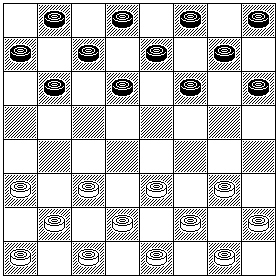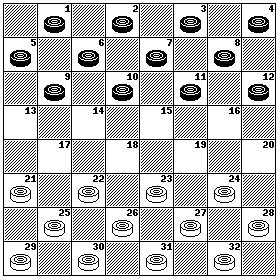
The game of Checkers (known as Draughts in Britain) is a traditional game that is more popular for casual play than Chess in the English-speaking world.
Only the dark squares of the board are used. A checker can be moved one square diagonally forwards, and it can also jump over one or more of the opponent's men, capturing them in doing so. As long as a capturing move is possible, one must be made: that is, if more than one capturing move is available, any capturing move can be chosen, but whichever sequence of multiple captures is chosen, it must be followed to completion.
When a checker (or man) reaches the opponent's back rank, it promotes to a king. A king has the additional power of moving and jumping backwards in addition to forwards.
The rule that capture, when possible, is compulsory was added to Checkers in France at some time around the year 1535; the game with this rule was called the Jeu Forcé, while the older game without that rule was known, in contrast, as the Jeu Plaisante.

To make diagrams of checker positions easier to read, by convention the light and dark coloring of the squares is reversed in such a diagram. Also, the squares of the board are numbered to facilitate the recording of moves in a game; this numbering is shown in the diagram at left.
Incidentally, I have encountered an old book on games which claimed that the checkers were placed on the light squares, and not the dark ones, for English checkers... except when the game was played in Scotland. Apparently, therefore, placing the board in the same orientation for both Checkers and Chess constitutes a recent innovation.
The possible first moves for the dark pieces are, therefore, noted as 9-13, 9-14, 10-14, 10-15, 11-15, 11-16, and 12-16. The usually preferred move is 11-15. The possible moves for the light pieces, the player with them moving second, are independent of the first move of the dark pieces, and are 21-17, 22-17, 22-18, 23-18, 23-19, 24-19, and 24-20.
Although 11-15 is the preferred initial move, the others are also playable, and, thus, they are given names as openings:
9-13 Edinburgh 9-14 Double Corner 10-14 Denny 10-15 Kelso 11-15 Old Faithful 11-16 Bristol 12-16 Dundee
There are also Checkers openings consisting of sequences of multiple moves, just as in Chess:
Old Fourteenth 11-15 23-19; 8-11 22-17; 4- 8
Alma 11-15 23-19; 8-11 22-17; 3- 8
Centre 11-15 23-19; 8-11 22-17; 15-18
Glasgow 11-15 23-19; 8-11 22-17; 11-16
Laird and Lady 11-15 23-19; 8-11 22-17; 9-13 17-14; 10-17 21-14;
Black Doctor 11-15 23-19; 8-11 22-17; 9-13 17-14; 10-17 19-10; 7-14
Laird and Lady Refused 11-15 23-19; 8-11 22-17; 9-13 25-22;
Glasgow-Whilter 11-15 23-19; 8-11 22-17; 9-14 25-22; 11-16 26-23;
Nailor 11-15 23-19; 8-11 26-23;
Tillicoultry 11-15 23-19; 8-11 22-18;
Will o' the Wisp 11-15 23-19; 9-13
Defiance 11-15 23-19; 9-14 27-23;
Fife 11-15 23-19; 9-14 22-17; 5- 9
Souter 11-15 23-19; 9-14 22-17; 6- 9
Whilter 11-15 23-19; 9-14 22-17; 7-11
or 11-15 23-19; 7-11
Whilter-Exchange 11-15 23-19; 7-11 22-18;
Maid of the Mill 11-15 22-17; 8-11 17-13; 15-18
Douglas 11-15 22-17; 8-11 17-13; 4- 8 25-22;
Pioneer 11-15 22-17; 8-11 25-22;
White Dyke 11-15 22-17; 8-11 17-14;
Wagram 11-15 22-17; 9-13 24-20;
Boston 11-15 22-17; 9-13 17-14;
Dyke 11-15 22-17; 15-19
Cross 11-15 23-18;
Waterloo 11-15 23-18; 8-11 18-14;
Ayrshire Lassie 11-15 24-20; 8-11 28-24;
Switcher 11-15 21-17;
Single Corner 11-15 22-18;
Second Double Corner 11-15 24-19;
Bristol 11-16 24-20; 16-19
Paisley 11-16 24-19;
Bristol-Cross 11-16 23-18;
White Doctor 11-16 22-18; 10-14 25-22; 8-11 24-20; 16-19 23-16; 14-23 26-19;
The opening noted above as "Second Double Corner" was also previously known as the "Invincible" opening. Also, the "Black Doctor" is also known as the "Nonsuch", the "Bristol-Cross" is also known as the "New Bristol", the "Douglas" is also known as the "Lady of Lorna", the "Waterloo" is also known as the "Boston-Cross"; and the "Old Fourteenth" was also known as the "Old Thirty-Ninth" and the "Old Forty-First". Note that the appelation "Bristol" was used both for 11-16 as a single move, and a three-move opening starting with that move. Also, the "Souter" opening is sometimes spelled as the "Suter" opening.
The "Laird and Lady Refused" was eventually found to be a loss for the second player, and thus is not a recommended opening. The "Glasgow-Whittier", although not a certain loss, makes for a very difficult game and is thus also not recommended.